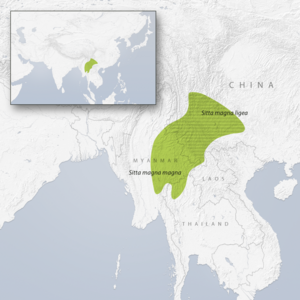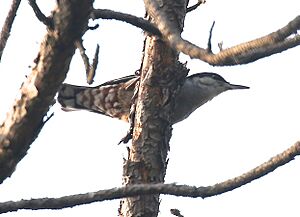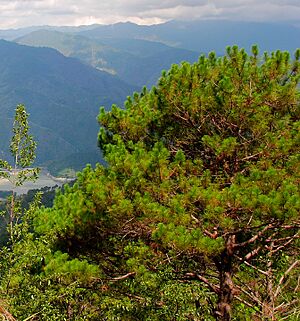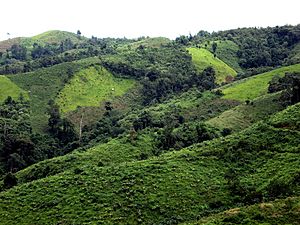Giant nuthatch facts for kids
Quick facts for kids Giant nuthatch |
|
|---|---|
 |
|
| An individual of the nominal subspecies, Sitta magna magna, on the ground in Thailand. | |
| Conservation status | |
| Scientific classification | |
 |
|
| Distribution of the giant nuthatch |
The giant nuthatch (Sitta magna) is a type of bird. It belongs to the Sittidae family, which includes all nuthatches. This bird is the biggest of all nuthatches. It measures about 19.5 centimeters (7.7 inches) long.
Its back and wings are bluish-gray. The top of its head and upper back are lighter gray. This lighter area stands out against the darker rest of its back. The giant nuthatch has two thick black stripes above its eyes. Its belly is light gray, with white cheeks and throat. Its lower belly can look a bit buff or cinnamon colored. This bird has a long beak and tail for a nuthatch.
You can tell the female apart from the male. The female's eye stripes are not as bright. Also, the colors on her upper back are less contrasting. The giant nuthatch makes loud calls that repeat simple sounds. It finds its food by searching on tree trunks and branches. It especially likes pines. It eats insects and berries. This bird usually builds its nest in a tree hole around March. The nest often has about three young birds.
Giant nuthatches live from southwest China to parts of Myanmar, Thailand, and possibly Laos. They live in mountains, from about 1,000 meters (3,300 feet) up to 3,350 meters (11,000 feet) high in China. They like to search for food in pine forests, especially old Benguet Pine trees. These trees grow on mountain ridges among oak and chestnut trees.
There are two main types, or subspecies, of giant nuthatch. They are called S. m. magna and S. m. ligea. They mostly differ in the size of their beaks. The giant nuthatch is in danger because its home is being destroyed. It lives in very specific places. Scientists thought there were more of them, but their numbers seem lower. Because of this, in 2013, the International Union for Conservation of Nature changed its status from "vulnerable" to "endangered".
Contents
What is the Giant Nuthatch?
Naming and Types
The giant nuthatch was first described in 1876. A British scientist named Robert George Wardlaw-Ramsay gave it its scientific name, Sitta magna.
Scientists divide the Sitta group of birds into smaller sections. The giant nuthatch is part of the main Sitta group. According to bird experts, there are two subspecies of the giant nuthatch:
- S. m. ligea: This type was described in 1938. It lives in south-central China. Its beak is shorter and thinner than the other type.
- S. m. magna: This is the original type described in 1876. It is found in Myanmar, central China, and northwest Thailand.
These two types likely mix in the Yunnan region of China.
How is the Giant Nuthatch Related to Other Birds?
For a long time, scientists were not sure how the giant nuthatch was related to other nuthatches. Some thought it was similar to the blue nuthatch or the beautiful nuthatch. However, these birds live in tropical areas and have bright colors.
Other ideas linked the giant nuthatch to the Eurasian nuthatch. In 2014, scientists studied the DNA of 21 nuthatch species. They found that the giant nuthatch is closely related to the white-breasted nuthatch. This was a surprise, as earlier studies based on looks linked the white-breasted nuthatch to a different species.
Here is a simplified family tree of some nuthatches:
|
||||||||||
|
||||||||||
What Does the Giant Nuthatch Look Like?
The giant nuthatch has dark bluish-gray upper parts. Its head, neck, and upper back are a lighter gray. This lighter area can have some black streaks. Two thick black stripes frame its head, running above its eyes and down to its upper back. When you see the bird from the side, its head might even look black.
Its underside is light gray. Its cheeks and throat are almost white. The belly often has a cinnamon color. The feathers under its tail are reddish-brown with large white spots. The bird's eyes are brown. Its beak is black, but the bottom half is lighter, like bluish-white. Its feet and toes are grayish or yellowish-brown, with dark claws.
Differences Between Males and Females
Male and female giant nuthatches look a bit different. The male has very dark black eye-stripes. His cheeks and throat are off-white. The rest of his underside is pale gray, sometimes with a slight buff color on the belly.
The female's upper parts are also different. Her neck and upper back have a slight buff color. The lower part of her back is lighter than the male's. This makes the contrast with her neck less strong. Young birds look like females. Their heads are duller, and their upper parts are more gray than blue.
Size and Similar Birds
The giant nuthatch is the largest nuthatch, measuring about 19.5 cm (7.7 inches). Its large size usually makes it easy to spot. However, it could sometimes be confused with the chestnut-vented nuthatch (Sitta nagaensis). The chestnut-vented nuthatch has reddish sides and much smaller black eye-stripes. It also does not have a lighter head and upper back like the giant nuthatch.
The Yunnan nuthatch (S. yunnanensis) can live in the same areas in southern Yunnan. But it is much smaller and has a white stripe above its eye.
Giant Nuthatch Behavior and Life
Vocalization
The giant nuthatch has a loud voice. It often makes a calling sound that reminds people of crows. It sounds like the chattering of a Eurasian magpie. This call has three rough notes repeated quickly, like "gd-da-da" or "get-it-up." Sometimes, this chatter is more musical. It becomes a series of sounds like "kid-der-ku." The first notes are dry, but the last note is strong and clear.
The notes can also be rougher, like a repeated "gu-drr, gu-drr, gu-drr." This sounds a bit like some game birds. The giant nuthatch also has a "naa" call, which sounds like a child's toy trumpet. Its song might be a clear, whistling sound, like "kip" or "keep." It repeats these sounds at different times and sounds like a loud tree frog.
Behavior and Diet
The giant nuthatch moves around like other nuthatches. It often hangs upside down on trees. However, it is usually calmer than smaller nuthatch species. It flies straight for short distances, with fast wingbeats. Its wide, butterfly-like wings are easy to see when it drops from one branch to another. For longer flights, it has a wavy flight, similar to a woodpecker.
This nuthatch usually searches for food alone or in pairs. They often look in pine trees. They explore the tree trunk and large branches. But they have also been seen looking for insects on thinner branches. Scientists have studied what they eat by looking at their stomach contents. Their diet includes berries and insects like beetles, butterflies (larvae), and ants.
Reproduction
We don't have much information about how the giant nuthatch reproduces. On April 4, 1933, a nest was found in southern Shan State. It had three young birds that were partly feathered. The nest was in a natural hole in a tree trunk, facing upwards. It was more than 2 meters (6.6 feet) above the ground. Unlike other nuthatches, it was not sealed with mud.
On April 8, 1983, another nest was found in northwest Thailand. It also had three young birds. This nest was in a hollow oak tree, about 3 meters (10 feet) off the ground. In 1998, another nest was found in Thailand in late March. It was in the trunk of a Benguet Pine tree and contained young birds.
Where Does the Giant Nuthatch Live?
The giant nuthatch prefers pine forests. But it can also be found in more open areas, flying from one small tree to another to find food. In Thailand, it lives among oak and chestnut forests. It often finds large, old Benguet Pine trees on mountain ridges.
It lives at medium to high altitudes. In China, it usually lives in forests above 1,000 meters (3,300 feet), up to at least 3,350 meters (11,000 feet). In Myanmar, it is found from 1,220 meters (4,000 feet) to 1,830 meters (6,000 feet). In Thailand, it lives from 1,200 meters (3,900 feet) to 1,800 meters (5,900 feet).
The giant nuthatch lives from south-central China to northwest Thailand. In China, it is found in southern Sichuan and Guizhou. Further south, it lives in much of Yunnan province. In Myanmar, it lives in Shan State. However, there have been fewer sightings since 1950, so its range there might have shrunk. It is probably in the far northwest of Laos, as it lives in nearby Myanmar and Yunnan. However, searches in 2013 did not find any.
It also lives in northwest Thailand. It has been seen in mountains like Doi Ang Khang and Doi Pha Hom Pok. It was reported in Doi Inthanon in the early 1980s. But this might have been a mistake, as the large pine forests it needs are not common there. It seems to have disappeared from Doi Suthep-Pui National Park in Thailand, where it was seen in the 1960s.
Why is the Giant Nuthatch Endangered?
The giant nuthatch was once described as "not rare" in Myanmar. But sightings have gone down since 1950, which means its living area might be shrinking. It is rare in China, and its numbers are falling. However, it is quite stable in Yunnan. Large-scale tree cutting is banned in most forests. But cutting trees for pine resin and firewood still destroys old trees, which the nuthatch needs.
In Thailand, the giant nuthatch is uncommon and lives only in certain places. It is found below 1,800 meters (5,900 feet) there. Most of its habitat at this height is being destroyed for farming and firewood. Pine trees are especially targeted. Giant nuthatches have been seen in live animal markets. But illegal hunting is probably not a major threat. However, four years of drought in Yunnan before 2013 likely reduced how many young birds survived.
Scientists estimate there are only 1,000 to 2,499 adult giant nuthatches left in the world. The largest group in Yunnan has only 6 to 50 adult birds. In 2012, the International Union for the Conservation of Nature called the species "vulnerable". But in 2013, they realized its numbers were even lower. So, the giant nuthatch is now considered "endangered". Also, the groups of birds are likely getting smaller and more separated.
A study in 2009 looked at how climate change might affect nuthatches in Asia. It suggested that the giant nuthatch's living area could shrink by 18% to 24% by the years 2040 to 2069.
The species lives in many protected areas in China and Thailand. A program to raise public awareness was started in Yunnan in 2007. BirdLife International suggests more studies. We need to know exactly where the giant nuthatch lives, how many there are, and what its habitat is like. This will help protect the species better. It is very important to set up protected areas in healthy pine forests and control how these forests are used.





